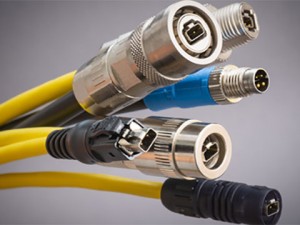Single Pair Ethernet for robotics applications
 Up until now, industrial Ethernet has only been able to reach the control level before it needs to switch to BUS systems via gateways. Single Pair Ethernet (SPE), delivered via HARTING’s T1 Industrial connector, allows equipment to connect via end-to-end IP-based communications right up into the field level.
Up until now, industrial Ethernet has only been able to reach the control level before it needs to switch to BUS systems via gateways. Single Pair Ethernet (SPE), delivered via HARTING’s T1 Industrial connector, allows equipment to connect via end-to-end IP-based communications right up into the field level.
HARTING says there is immense potential for this new technology in robotics applications, where the cables are subjected to strong torsional forces, the reduced number of wires means thinner and more flexible cables, which prolongs their service life.
Single Pair Ethernet (SPE) will be one of the technological cornerstones that helps to shape the success of the IIoT. The factory of the future will require high data streams and the industrial sector needs connectivity solutions which adapt themselves to increasingly growing demands.
The T1 Industrial supplies both data and power via Power over Data Line (PoDL) across a single pair of wires in an IEC 63171-6 industrial interface, bringing Ethernet from the cloud to every sensor and enabling Industry 4.0.
Key aspects of the T1 include the space-saving and weight reduction benefits achieved by the move to a single pair of wires. This means the compact T1 can be easily incorporated into smaller products and Ethernet interfaces can be designed onto simple sensors, cameras, reading/ID devices or similar miniaturised equipment.
For maximum flexibility, the T1 mating face can be integrated into standard housing forms as required, including interfaces in M8 and M12 housings. HARTING not only has connectors and other components in mind but a complete Single Pair Ethernet system which will quickly and securely deliver higher bandwidth and large volumes of data, right down to the printed circuit board.
Matthias Fritsche, HARTING’s Ethernet communications expert, comments: “SPE is about conveying the Ethernet protocol with another physical layer using only a single pair of wires. So just as one is currently using four-pair copper cables, fibre-optic cables or radio today, SPE is another form of physical layer, designed for communication down to the field level.”
Highlighting the benefits of SPE for the user, Marian Duemke, HARTING global product manager, adds: “The idea behind SPE is to bring Ethernet to the field level, where it isn’t available yet. SPE means Ethernet interfaces can now be integrated onto simple sensors, cameras, reading/ID devices or similar miniaturised equipment. As a result, there is immense potential in the T1, which can supply both data and power across a single pair of wires in an IEC 63171-6 industrial interface.”
Addressing some of the other markets that could benefit from SPE, Duemke says: “Within transportation, an Ethernet cable weighs approximately 4.6kg per 100 metres, whereas an SPE cable only 3kg. Over an average train carriage lifetime of 40 years, each kilogram of saved weight delivers savings of around £12,000 per carriage. If you consider how many carriages the average train has and how many miles of cable are found in the train, it soon becomes apparent how great the savings potentials are.”
Discussing how the HARTING T1 Industrial connector was developed, Fritsche says: “For the concept, we examined the trends of recent decades and what the ideal plug connector should look like. To do this, we looked at the pain points of the RJ45. We decided on a pin and socket system as these are already established for many industrial connectors. We also enabled a safe interlock so that shocks and vibrations don’t interrupt the data transmission.
“Companies are starting to understand SPE’s benefits and are working on projects already. This has shown us that we are on the right track and that people understand that this is not just some kind of new Ethernet interface. It’s a completely new world that harbours an incredibly great potential.”
Visit the Harting website for more information















